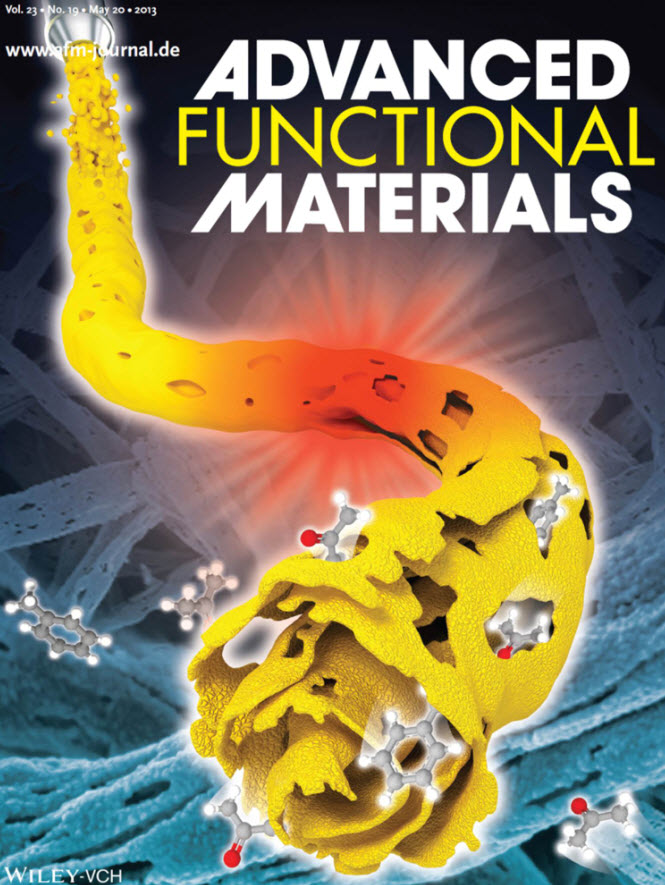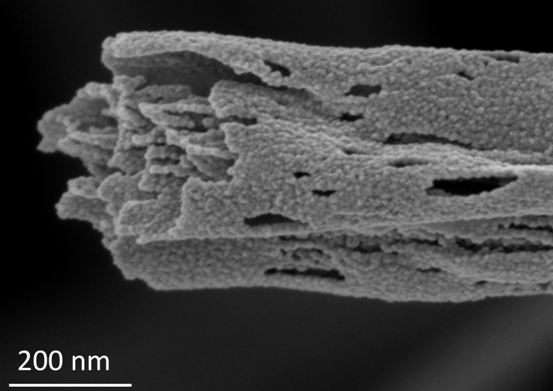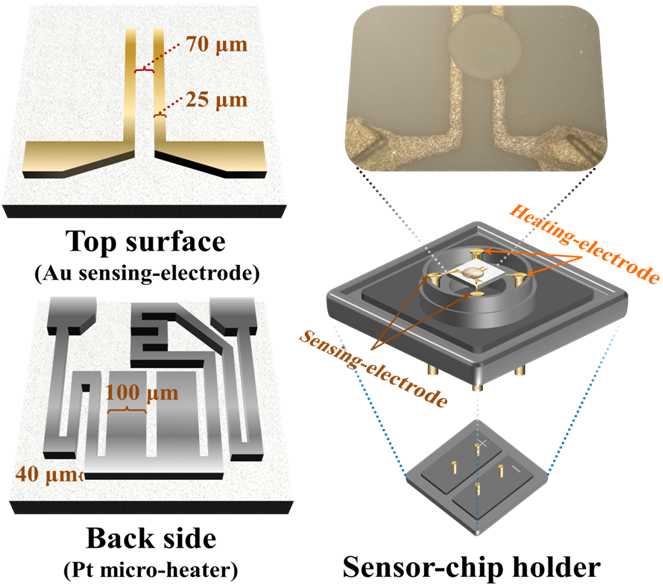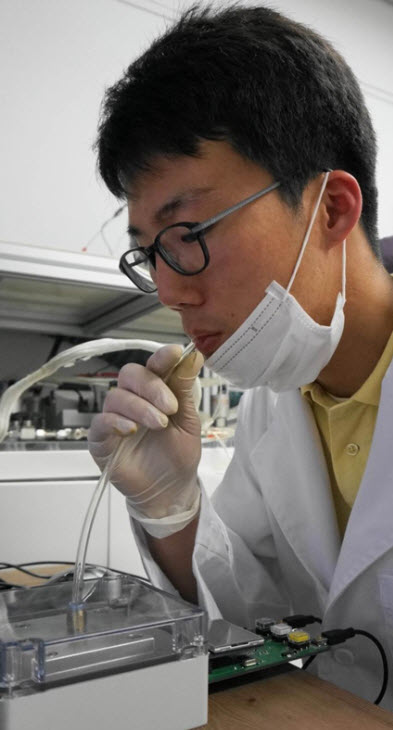Nanofiber sensor instantly detects diabetes or lung cancer in breath
June 13, 2013

The research is described in a recently published cover paper in Advanced Functional Materials (credit: Wiley)
Researchers at the Korea Advanced Institute of Science and Technology (KAIST) have developed a highly sensitive exhaled-breath sensor, using tin dioxide (SnO2) fibers assembled from thin, wrinkled SnO2 nanotubes.
These metal-oxide nanofiber-based chemiresistive gas sensors allow for portable real-time breath tests that could be available on smart phones or tablets in the near future.
They sensors allow for diagnosing serious diseases such as diabetes or lung cancer quickly and effectively by simply breathing into a small nanofiber breathing sensor, mounted on a phone or other device..
The SnO2 fibers, called “micro phase-separations,” are generated between polymers and dissolved materials while varying the flow rate of an electrospinning solution feed and then applying a heat treatment.
The change in form results in nanofibers shaped like an open cylinder. Inside the cylinder, thin-film SnO2 nanotubes are layered and then rolled up.
A number of elongated pores ranging from 10 nanometers (nm) to 500 nm in length along the fiber direction are formed on the surface of the SnO2 fibers, allowing exhaled gas molecules to easily permeate the fibers.

Thin-wall assembled SnO2 diabetes sensor using highly porous nanofibers synthesized by electrospinning at a high flow rate (credit: KAIST)
The inner and outer walls of the SnO2 tubes are evenly coated with catalytic platinum (Pt) nanoparticles.
According to the research team, highly porous SnO2 fibers, synthesized by eletrospinning at a high flow rate, showed five-fold higher acetone responses than that of the dense SnO2 nanofibers created under a low flow rate.
The catalytic Pt coating shortened the fibers’ gas response time dramatically as well.
Instant breath tests for diabetes, lung cancer, and kidney malfunction
The breath analysis senses specific volatile organic compounds (VOC) produced in the human body to signal the onset of particular diseases. Different biomarkers predict specific diseases — acetone for diabetes, toluene for lung cancer, and ammonia for kidney malfunction.
Breath analysis for medical evaluation has attracted much attention because it is less intrusive than conventional medical examination, fast, convenient, and environmentally friendly, leaving almost no biohazard wastes.
Various gas-sensing techniques have been adopted to analyze VOCs including gas chromatography-mass spectroscopy (GC-MS), but these techniques are difficult to incorporate into portable real-time gas sensors because the testing equipment is bulky and expensive, and their operation is more complex.
Sensitivity of less than 100 parts per billion

Components of exhaled breath sensor, showing optical microscope image (right, top) of exhaled breath sensing layer coated on sensor substrate (credit: KAIST)
Metal-oxide based chemiresistive gas sensors, however, offer greater usability for portable real-time breath sensors, according to Il-Doo Kim, Associate Professor, KAIST Materials Science and Engineering Department.

A breath test with lab prototype device (credit: KAIST)
“Catalyst-loaded metal oxide nanofibers synthesized by electrospinning have a great potential for future exhaled-breath-sensor applications,” he said.
“From our research, we obtained the results that Pt-coated SnO2 fibers are able to identify promptly and accurately acetone or toluene even at very low concentration — less than 100 parts per billion (ppb).”
The exhaled acetone level of diabetes patients exceeds 1.8 parts per million (ppm), which is two- to six-fold higher than that (0.3-0.9 ppm) of healthy people.
So a highly sensitive detection that responds to acetone below 1 ppm, in the presence of other exhaled gases (and also under the humid environment of human breath), is important for an accurate diagnosis of diabetes.
“A trace concentration of toluene (30 ppb) in exhaled breath is regarded to be a distinctive early symptom of lung cancer, which we were able to detect with our prototype breath tester,” he said.
Clinical trials
The research team is now developing an array of breathing sensors using various catalysts and a number of semiconducting metal oxide fibers, which will offer patients real-time easy diagnosis of diseases.
“We already tested one time with diabetes patients and we are going to conduct in-depth clinical trails at a hospital in Korea within a couple of months,” Kim told KurzweilAI.
“The sensor technology can be compatible with various types of smartphones, portable electronic gadgets, and medical devices,” he added. “We believe that there can be many ways to incorporate our technology based on particular needs of industries, not just in the medical device field, such as detecting hazardous chemicals or gas at manufacturing factories.”